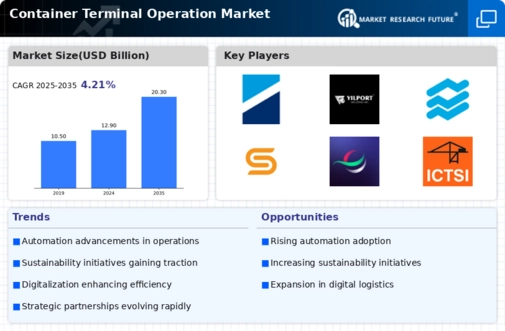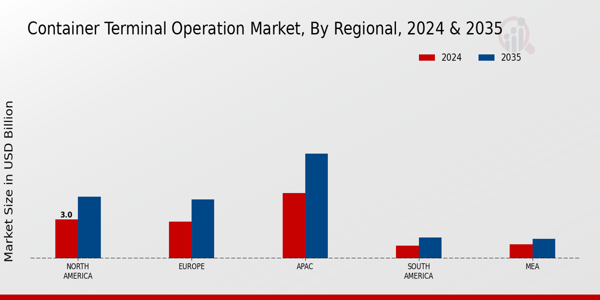Market Growth Projections
The Global Container Terminal Operation Market Industry is poised for substantial growth, with projections indicating a market value of 20.3 USD Billion by 2035. This growth trajectory is supported by a compound annual growth rate (CAGR) of 4.21% from 2025 to 2035. The increasing demand for efficient container handling and logistics solutions is driving investments in terminal operations. As global trade continues to expand, terminal operators are likely to enhance their capabilities to meet the evolving needs of shipping lines and cargo owners. This trend underscores the importance of strategic planning and investment in technology and infrastructure.
Increasing Global Trade Volumes
The Global Container Terminal Operation Market Industry is experiencing growth driven by rising global trade volumes. As economies expand, the demand for containerized shipping increases, necessitating efficient terminal operations. In 2024, the market is valued at 12.9 USD Billion, reflecting the heightened activity in international trade. This trend is expected to continue as countries seek to enhance their export capabilities. For instance, the Asia-Pacific region, being a major hub for manufacturing, contributes significantly to container traffic. Enhanced logistics and infrastructure investments further support this growth, indicating a robust future for terminal operations.
Expansion of Port Infrastructure
The expansion of port infrastructure is a critical driver in the Global Container Terminal Operation Market Industry. As container traffic increases, ports are investing in expanding their facilities to accommodate larger vessels and higher cargo volumes. This includes deepening berths and enhancing loading and unloading capabilities. For instance, major ports in Europe and Asia are undergoing significant upgrades, which are projected to increase their capacity by over 25% by 2035. Such expansions not only improve operational efficiency but also position these ports as key players in global trade, thereby driving further investments in terminal operations.
Emerging Markets and Regional Growth
Emerging markets are contributing significantly to the Global Container Terminal Operation Market Industry. Regions such as Africa and Southeast Asia are witnessing rapid economic growth, leading to increased demand for containerized shipping. As these economies develop, they are investing in port infrastructure and logistics capabilities. For example, the African continent is projected to see a 5% annual growth in container traffic, driven by urbanization and industrialization. This growth presents opportunities for terminal operators to expand their services and enhance their market presence. The overall market is expected to reach 20.3 USD Billion by 2035, with a CAGR of 4.21% from 2025 to 2035.
Technological Advancements in Automation
Technological advancements play a pivotal role in the Global Container Terminal Operation Market Industry. Automation technologies, such as automated guided vehicles and advanced terminal operating systems, streamline operations and improve efficiency. These innovations reduce operational costs and enhance turnaround times for vessels. For example, ports implementing automated systems have reported up to a 30% increase in productivity. As terminals adopt these technologies, they are likely to attract more shipping lines, thereby increasing their market share. The integration of digital solutions also enhances data analytics capabilities, allowing for better decision-making and operational planning.
Sustainability Initiatives and Regulations
Sustainability initiatives are increasingly influencing the Global Container Terminal Operation Market Industry. Governments and regulatory bodies are imposing stricter environmental regulations, prompting terminals to adopt greener practices. This includes the use of electric cranes and eco-friendly fuels, which not only comply with regulations but also reduce operational costs in the long run. For instance, terminals that have invested in sustainable technologies have seen a reduction in emissions by up to 40%. As the market evolves, sustainability will likely become a key differentiator for terminals, attracting environmentally conscious shipping lines and enhancing competitiveness.









